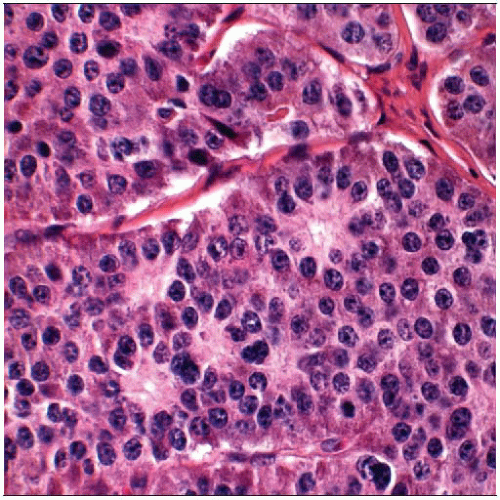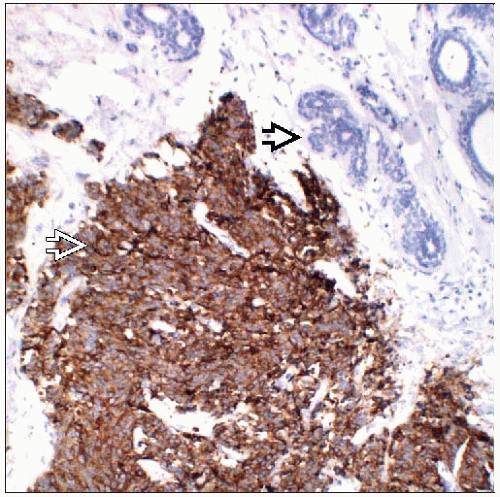Neuroendocrine/Small Cell Carcinoma
Key Facts
Terminology
WHO classification recognizes 3 categories of NEBC
Solid neuroendocrine carcinoma: Most common
Large cell neuroendocrine carcinoma
Small cell/oat cell carcinoma: Very rare
Carcinomas must have typical histologic features and express at least 1 neuroendocrine marker in > 50% of cells to qualify
However, this is a heterogeneous group of carcinomas and not all will easily fit into these 3 groups
Etiology/Pathogenesis
Gene expression profiling has shown that solid neuroendocrine carcinoma has transcriptional pattern identical to type B mucinous carcinomas (cellular mucinous carcinomas)
Clinical Issues
2-5% of breast carcinomas
Information on prognosis is limited due to small numbers of patients and varying definitions of NEBC
Solid neuroendocrine carcinoma, especially if associated with solid papillary pattern or mucin production, has better prognosis
Other types may have worse prognosis
Top Differential Diagnoses
Primary carcinoid tumor of breast
Metastatic carcinoid tumor
Metastatic small cell carcinoma
Breast carcinomas of no special type
Alveolar lobular carcinoma
TERMINOLOGY
Abbreviations
Neuroendocrine breast carcinoma (NEBC)
Solid neuroendocrine breast carcinoma (SNEBC)
Small cell/oat cell breast carcinoma (SCOCBC)
Large cell neuroendocrine breast carcinoma (LCNEBC)
Synonyms
Invasive carcinoma with endocrine differentiation (argyrophilic carcinoma)
Mammary carcinoma with endocrine features
Definitions
WHO classification recognizes 3 categories of neuroendocrine breast carcinoma
Solid neuroendocrine breast carcinoma
Small cell/oat cell breast carcinoma
Large cell neuroendocrine breast carcinoma
Carcinomas must have “morphologic features similar to those of neuroendocrine tumors of both gastrointestinal tract and lung”
Tumors must express at least 1 neuroendocrine marker in > 50% of cells to qualify
Some carcinomas with typical morphologic appearance will not express neuroendocrine markers
Alternatively, not all carcinomas that express neuroendocrine markers have a distinctive morphologic appearance
This is a heterogeneous group of carcinomas; not all cases will easily fit into 3 groups as defined by WHO
ETIOLOGY/PATHOGENESIS
Biology of NEBC
Gene expression profiling analysis of NEBC
NEBC belongs to luminal A subgroup
SNEBC has transcriptional pattern identical to type B mucinous carcinoma (hypercellular type)
This association is present whether or not mucinous carcinomas express neuroendocrine markers
Type A mucinous carcinomas (paucicellular) cluster in separate but related group
CLINICAL ISSUES
Epidemiology
Incidence
NEBCs comprise 2-5% of breast carcinomas
Age
NEBC has same age distribution as carcinomas of no special type; median age at diagnosis is 61 years
Presentation
NEBC usually presents as palpable mass or mammographic density
Calcifications have not been associated with these tumors
Very rare breast carcinomas produce ectopic hormones
Human chorionic gonadotropin, calcitonin, adrenocorticotrophic hormone, parathormone, and epinephrine have been reported
Clinical symptomatology from these hormones is very rare
Treatment
Not altered by presence of neuroendocrine markers
Prognosis
Information is limited due to small numbers of patients and varying definitions of NEBC
In small studies, SNEBC, especially if associated with solid papillary pattern or mucin production, has better prognosis
In 1 study, LCNEBC had worse prognosis compared to matched controls with carcinomas of no special type
IMAGE FINDINGS
Radiographic Findings
No specific imaging features
MACROSCOPIC FEATURES
General Features
No specific gross features
MICROSCOPIC PATHOLOGY
Histologic Features
Histologic types of NEBC are recognized in WHO classification
Solid neuroendocrine breast carcinoma (SNEBC)
Most common type of NEBC
Tumors form circumscribed or lobulated masses that may be solitary or multiple
Cell nests may be separated by delicate septae; some have solid papillary pattern
Cell type can vary from spindled to epithelioid
Peripheral palisading and rosette formation may be present
About 25% are associated with at least focal extracellular mucin or intracellular mucin
Small cell/oat cell breast carcinoma (SCOCBC)
Stay updated, free articles. Join our Telegram channel

Full access? Get Clinical Tree






